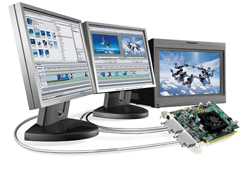
PRODUCT: Matrox Parhelia AVPe
WEB SITE: www.matrox.com
- x16 PCI Express native
- Multiple Triple monitor configurations including output to an HD monitor
- Very reasonable MSRP of $349
It was about a year ago that I did an overview of the big changes going on in the graphics card and graphics accelerator industry with the rapid introduction of PCI Express. At that time, I reported that Matrox Graphics, Inc. (www.matrox.com/graphics), had not yet introduced a PCI Express based graphics card, though I hinted they were close. Early this year, as promised, they did introduce their first x16 PCI Express card, the Parhelia APVe. The APV stands for Audio, Photo, and Video. It is designed to meet the demanding needs of professional in these areas.
Think in 3s and HD
Screen real estate is always an issue for professionals. Whether working with complex audio editing, video or digital photography, you often have multiple applications open and these applications have gotten so complex that they nearly always have multiple windows. Assuming of course your computer can handle the load of large multiple applications running, the Parahelia APVe has no problem giving you the screen real estate you need. I initially had mine connected to three analog flat-panel monitors. I say initially, because the Parhelia allows for lots of flexibility in how you can configure your outputs, but the magic number to remember is 3. There are multiple ways you can get 3 outputs with this card, and one of those outputs, when configured properly, can be to an HD monitor.
Flexibility and WYSIWYG
After my initial triple analog flat panel set-up, I decided to rearrange things a bit. Matrox does a great job at supplying most of the cables for the many configurations the Parhelia APVe is capable of and I kept two of the flat panel monitors connected but then connected the third output to a standard NTSC TV monitor. On this monitor was a WYSIWYG (What-You-See-Is-What-You-Get) output from a Photoshop file I was working on. All the while I still had my other two flat panel monitors operating in a standard dual-monitor mode. Pretty cool, but it got better. You see, the Photoshop file I was working on was meant for HD display in the 16x9 aspect ratio. It really looked pretty funky on the 4x3 NTSC monitor. The Parhelia APVe was able to assist me in fixing this with no problem. After a few pretty simple cable and software changes, I had the same file displayed in 16x9 WYSIWYG on an HD monitor. Now that was really cool. While I tried the WYSIWYG functionality of the Parhelia APVe in Adobe Premiere Pro, After Effects and Photoshop, it is also capable of WYSIWYG output to NTSC standard definition and HD monitors from other common applications, such as Autodesk Combustion 3, Autodesk 3DS Max and NewTek LightWave 3D.
While I didn't try them all, a few of the other configurations the Parhelia APVe is capable of include dual digital flat screens plus an NTSC TV out, dual-RGB monitors plus HDTV out, triple RGB monitors, and dual-analog flat panels plus a digital flat panel. The NTSC TV out can be composite or S-video and the HDTV output is YPbPr component at 1080i/25, 1080i/30, 1080p/24, 1080p/25, 1080p/30, 720p/60, 483p/60, 480p/59.94 and 576p/50. Additionally, with some optional cables, you can even get analog composite or S-Video into the Parhelia APVe. This amazing flexibility obviously comes from a great hardware design by Matrox, but not to be overlooked is the very solid software and drivers that Matrox has developed over its many years of creating great graphics cards.
Hardware is nothing without the software to open it up, and Matrox has done an excellent job making sure you'll get the most out of this card regardless of whether you're running under Microsoft Windows XP or Windows 2000. The bundled software gives you features like gamma correctable Dual Hardware Overlay support, PureVideo Preview allowing for full-screen video playback and adjustable proc-amp controls for the video window and TV. The software includes the Matrox PowerDesk-HF utility suite which is an interface for adjusting board-level and multi-display parameters, and the previously discussed WYSIWYG video output plug-ins.
Thinking about specs and intended applications
I have used and reviewed some much beefier cards than this one - and all of them came with much beefier price tags. With 128MB of memory, the Parhelia APVe won't take any prizes in that area, but for its intended use, it's more than adequate. This video card is meant to allow digital content creators the ability to use their most common applications with plenty of screen real estate on dual monitors and simultaneously have output to a standard definition or HD television monitor. It does all this with native x16 PCI Express architecture, and Dual 400MHz 10-bit RAMDACs. It uses what Matrox calls "UltraSharp Display Output technology" and is OpenGL and Microsoft DirectX compliant.
Conclusion
If you're doing lots of heavy 3D work needing lots of horsepower for complex shading and renders, this card is probably not for you. But if lots of screen real estate with exceptionally high quality color rendition and WYSIWYG output to a television monitor is something that interests you, then the Parhelia APVe might be just what you're looking for. At a suggested retail price of $349, for its features, flexibility, and quality, it seems a very good value.